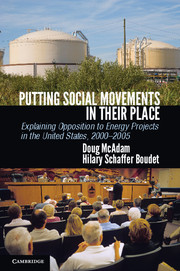 Putting Social Movements in their Place
Putting Social Movements in their Place Published online by Cambridge University Press: 05 June 2012
From its modest beginnings during the 1970s and early 1980s, the study of social movements has developed into one of the largest subfields in American sociology. In recent years, scholars in a host of other disciplines or fields – including political science (Beissinger 2001; Bunce 1999; Dalton, Van Sickle, and Weldon 2009; della Porta 1995; Dosh 2009; Kitschelt 1995; Koopmans 1993; Kriesi et al. 1995; O’Brien and Li 2006; Tarrow 2005; Wood 2003; Yashar 2005), organizational studies (Davis and McAdam 2000; Davis et al. 2005; Ingram, Yue, and Rao 2010; Lounsbury 2005; Rao, Monin, and Durand 2003; Strang and Soule 1998; Vogus and Davis 2005), education (Binder 2002; Davies and Quirke 2005; Hallett 2010; Rojas 2006, 2007; Slaughter 1997; Stevens 2001), environmental studies (Aldrich 2008; Rootes 2003; Rucht 1999; Sherman 2011; Vasi 2011), and law and society (Edelman, Leachman, and McAdam 2010; Gustafsson and Vinthagen 2011; Kay 2005; McCann 1994; Pedriana 2006) – have turned increasingly to social movement theory in an effort to better understand the dynamics of conflict and change within their respective scholarly domains. But even as we acknowledge and celebrate the vibrancy of the field, we worry about what we see as its increasing narrowness. In his 2009 article in Annual Review of Sociology, Andrew Walder voices similar concerns, criticizing what he sees as the field’s preoccupation with the dynamics of “mobilization” and general disinterest in a host of broader topics, including the traditional focus among political sociologists on the macrolinks between social structure and various forms of political behavior. There are, however, two other sources of “narrowness” in the field that concern us even more than the one identified by Walder.
To save this book to your Kindle, first ensure [email protected] is added to your Approved Personal Document E-mail List under your Personal Document Settings on the Manage Your Content and Devices page of your Amazon account. Then enter the ‘name’ part of your Kindle email address below. Find out more about saving to your Kindle.
Note you can select to save to either the @free.kindle.com or @kindle.com variations. ‘@free.kindle.com’ emails are free but can only be saved to your device when it is connected to wi-fi. ‘@kindle.com’ emails can be delivered even when you are not connected to wi-fi, but note that service fees apply.
Find out more about the Kindle Personal Document Service.
To save content items to your account, please confirm that you agree to abide by our usage policies. If this is the first time you use this feature, you will be asked to authorise Cambridge Core to connect with your account. Find out more about saving content to Dropbox.
To save content items to your account, please confirm that you agree to abide by our usage policies. If this is the first time you use this feature, you will be asked to authorise Cambridge Core to connect with your account. Find out more about saving content to Google Drive.